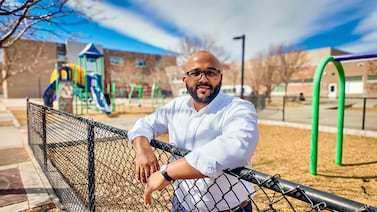Sign up for Chalkbeat New York’s free daily newsletter to keep up with NYC’s public schools.
Mayor Eric Adams has vowed that every family who wants a seat in New York City’s free preschool program for 3-year-olds will receive one, despite recent cuts to city funding for the early childhood system.
But as the city distributed 3-K offers on Thursday, some families say they didn’t receive a seat at any of the programs to which they applied.
Diana Sidakis, a public defender who lives in Manhattan, said she tried to be savvy with her application. She spent hours extensively researching programs, compiled spreadsheets, attended tours, and eliminated any programs that seemed unlikely to admit her son.
Despite applying to 12 programs, the maximum number, Sidakis did not receive a seat for her child. She was waitlisted at all of them.
“Every kid needs education at 3 years old,” she said. “They’re socially and developmentally ready, and it changes the rest of their life. So for Mayor Adams to say that he can cut this program and every family who wants a seat will get a seat, it’s just such a fraud.”
Building up the free prekindergarten system was a signature initiative of former Mayor Bill de Blasio, who leaned heavily on federal COVID relief dollars to expand preschool for 3-year-olds, aiming to make the program universal. That effort stalled under Adams, whose administration has justified funding cuts to the program by arguing that thousands of seats are sitting empty due to a mismatch of supply and demand in some neighborhoods. Advocates counter that the mayor has not invested in promoting preschool options to families.
This year, the city’s early childhood system has taken center stage in budget negotiations between City Council members and the Adams administration. Under a plan Adams proposed last month, the city would replace $92 million of expiring federal funding for 3-K with city and state funds — but it would not restore a separate $170 million in city funding that was cut from early childhood programs in November. Adams also promised to spend $5 million to help recruit more families to the city’s pre-K programs.
At a budget hearing on Wednesday, Education Department officials said enrollment in preschool programs, including the larger pre-K program for 4-year-olds, had grown to roughly 114,000 children. In total, there were about 53,000 seats in the city’s 3-K program, with about 44,000 filled.
Despite cuts to early childhood funding, Adams has remained adamant that “every child who wants a 3-K and pre-K seat will have access to one.”
In a statement Thursday evening, city officials emphasized that thousands of 3-K seats remained open and said the city would work with families who were not initially admitted to find nearby open seats.
“The mayor was clear: Every child who wants a seat will have access to a seat and he will keep his word,” said Amaris Cockfield, a spokesperson for City Hall. “The guidance sent to a limited number of families by New York City Public Schools, unfortunately, did not fully convey all the seats still available to New York City students.”
The city made offers to 94% of families who applied to 3-K on time, receiving approximately 43,000 applicants for about 52,000 seats across the city, according to city officials. The Education Department will send an “updated letter” to families about seats that remain open in 3-K.
Still, advocates were quick to condemn the mayor’s previous promises as some families received the news that they had not been offered a 3-K seat. As of Thursday afternoon, more than 20 families across the city had reached out to the advocacy group New Yorkers United for Childcare, informing them they had been rejected or waitlisted. Others told the group they were admitted to programs far from home, adding logistical challenges for parents seeking care for their young children.
“The impact cannot be understated: without free 3-K, childcare costs families an average of $20,000 a year per kid, with many spending more — a cost far too many families cannot afford,” said Rebecca Bailin, director of the group, in a statement. “Now, New Yorkers who are already facing a skyrocketing cost of living must decide whether to leave work and stay home with their child, drain their savings, or potentially leave the city altogether.”
Prior reports have shown a lack of access to affordable child care can have a significant impact on parents’ ability to work. More than half a million people did not seek employment in 2021 due to child care needs, and about 375,000 parents chose to leave or considered leaving their jobs due to the combined impact of the pandemic and a lack of affordable child care, according to a 2022 city report.
Sidakis said she’s unsure whether her family can afford to consider private child care options if she ultimately does not receive a 3-K seat that works for her family.
“It’s just an enormous, enormous source of financial and emotional stress,” she said.
“I really don’t want to leave the city,” Sidakis added. “I’m a public defender. I’ve devoted my life to public service. I want my kids to go to public school. I believe in public school. But this is really wrong.”
Alex Zimmerman contributed reporting.
Julian Shen-Berro is a reporter covering New York City. Contact him at jshen-berro@chalkbeat.org.





